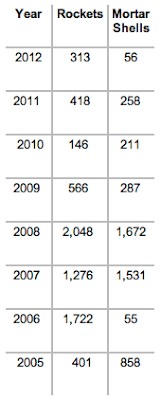
In my last posting, I briefly mentioned Israel's "Iron Dome", their air-to-air defense shield that is used to protect the country's populated areas from incoming Palestinian missiles. Here is a more in depth look at the system.
In 2005, Israel completely withdrew its security forces from the Gaza with the hopes of spurring the Middle East peace process. Unfortunately, the withdrawal has not worked; according to the Harvard Law School National Security Journal, since 2005, over 9000 rockets and mortar shells have been fired into neighbouring Israel. According to Shin Bet, Israel's Security Agency, these crude mortar shells have a range of roughly 6 miles with the technologically superior Grad missiles having a range of between 30 and 40 miles. According to B-Tselem, the Israeli Information Center for Human Rights in the Occupied Territories, between June 2004 and July 2012, 20 Israeli citizens, including four minors, and one foreign national were killed in Israel by Palestinian rocket and mortar fire. In addition, three Israeli soldiers were killed, one in Israel and two in the Gaza. Interestingly, Palestinian rocket friendly fire also killed nine Palestinians including six minors.
In the period between January 1 and June 30, 2012, Palestinians have fired a total of 313 rockets and 56 mortar shells from the Gaza strip into southern Israel. This compares to 418 rockets and 258 mortar shells in all of 2011, a substantial year-over-year escalation.
Here is a chart showing the number of rockets and mortars fired by year since 2005:
To combat the increasing use of such attacks by air, in 2007, Israel's Defense Minister Amir Peretz selected the Iron Dome as the country's answer to self-defense. The system, developed by the Israeli RAFAEL Armament Development Authority Ltd. is a three part system that includes a radar system to detect and track incoming rockets and mortars, a missile system that intercepts the incoming rockets and a battlefield management system that determines whether the threat is heading toward a populated area and whether or not it should be intercepted. The system is designed to determine the threat level of the incoming rocket so that unnecessary interceptions are avoided. This is key since the cost of the intercepting Tamir missiles runs at between $50,000 and $90,000 each, depending on the source. Each missile launching system runs at $50 million and, according to Bloomberg, four truck-towed batteries including launchers and interceptors have been fielded thus far.
Here is a diagram from RAFAEL showing how the system works:
Here is a video showing the Iron Dome system in action:
The system intercepted its first rocket on April 7, 2011, just days after implementation, destroying a Grad rocket over the city of Askelon. The drawback of the system is that it is designed for short-range rockets only. Mid-range missiles and rockets cannot yet be intercepted.
How effective is the system? In the recent conflict, Israel is claiming a 90 percent effectiveness rate. By comparison, according to the Israel Defense Forces back in the period between March 9 and 13, 2012, of over 300 rockets launched from Gaza only 165 reached Israeli soil. The Iron Dome system attempted in intercept 69 of the rockets and succeeded in destroying 56 of them, a 78.2 percent success ratio.
Just in case you thought that this was irrelevant to American taxpayers, in July 2010, the United States House of Representatives approved a $205 million fund to "spur the production and development of the Iron Dome". In addition, in April 2012, the House Armed Services subcommittee authorized another $680 million to help fund the Iron Dome. As well, Israel is exploring potential sales of the Iron Dome system to countries in Europe as a means of self-defense for troops stationed in hostile areas including Afghanistan. India and Singapore are both reportedly in negotiations to acquire the system and the United States has shown interest in the system. With nearly a billion dollars invested in this technology thus far, one would hope so.
Click HERE to read more of Glen Asher's columns
You can publish this article on your website as long as you provide a link back to this page.



Be the first to comment